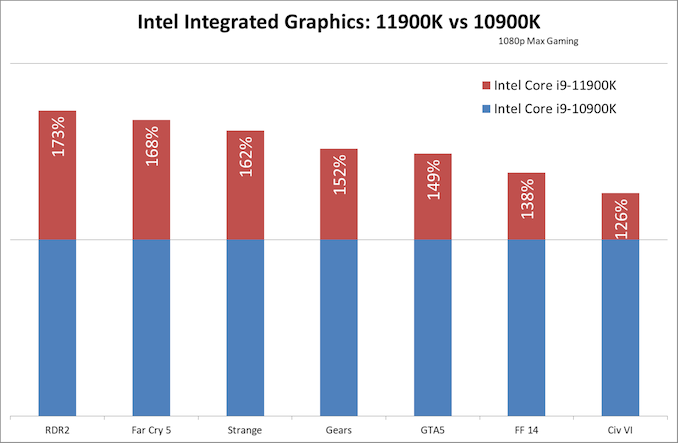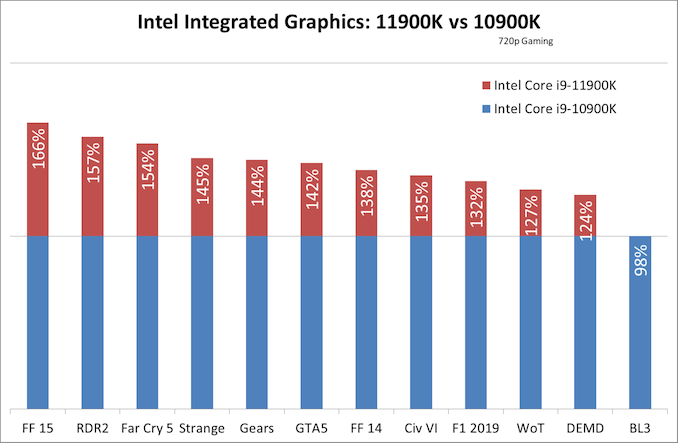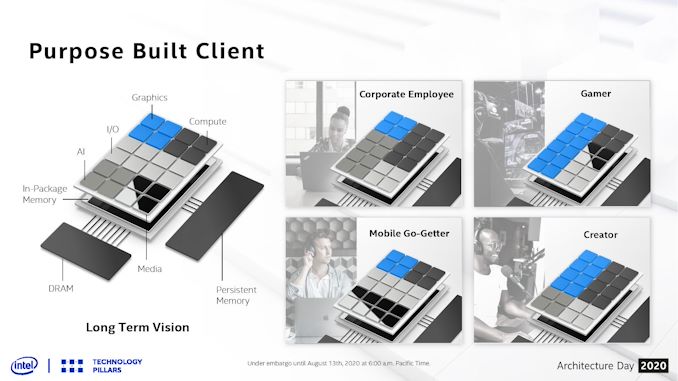Intel’s Integrated Graphics Mini-Review: Is Rocket Lake Core 11th Gen Competitive?
by Dr. Ian Cutress on May 7, 2021 10:20 AM ESTConclusions
No-one ever said that integrated graphics solutions had to be good. Nonetheless there is always the desire for something better, something higher performance, and something suitable for end-users. At the beginning of the era of integrated graphics, the focus was on simply providing something basic for 2D work - applications on an operating system and no real graphics rendering to mention. That solution is simple enough, however the demand on integrated graphics has grown over time, especially as the demands we put on our devices have also grown.
A modern system, especially a commercial system or one designed for work, has to do it all. Anyone not working in graphics might depend on a integrated solution to navigate complex arty web interfaces for the tool they use, or rely upon the acceleration features now baked into those platforms. Also perhaps, from time to time, some mild gaming use as well, if not outright using the compute features of the graphics for transcoding or AI. These demands are most heavily focused on mobile platforms, and as a result mobile platforms from Intel tend to get the best integrated graphics solutions, especially in thin-and-light designs where a discrete graphics solution is too power hungry. Intel's mobile Tiger Lake-U series offers a sizeable 96 execution units of the latest generation graphics architecture, compared to the desktop processors we are testing today, that only have 32.
So what use is a desktop processor with integrated graphics?
AMD and Intel both have product lines with integrated graphics. From Intel, its integrated graphics is in almost everything that Intel sells for consumers. AMD used to be that way in the mid-2010s, until it launched Ryzen, and now we have separate CPU-only and CPU+Graphics options. This is where the company philosophy differs.
AMD's desktop processors with integrated graphics are primarily intended to be a whole system replacement, with users relying on the integrated graphics for all their graphics needs. As a result AMD puts a lot more processing hardware into its integrated graphics solutions for the desktop, and it results in a good gaming experience for entry level gaming.
Intel's route on the otherhand is a bit more basic. The desktop integrated graphics here has two main directions: first, as the basic graphics needed for an office system, or second, more of a fall-back option for when the discrete card doesn't work or fails in more premium desktop systems. The power isn't there for hardcore grunt like gaming of any serious note, but it is certainly enough to cover the basics.
Despite this, with the new Xe-LP graphics solution, Intel has some aces up its sleeve. First is AV1 decoding, which allows users to watch AV1 content without putting stress on the CPU. Second is video encoding accelerationt through QuickSync, which has actually been a part of Intel's graphics for a number of years. Third is a relatively new feature: Intel's 'additional processor' mentality. Normally when a system has a discrete graphics card, the integrated graphics is disabled. But now, with its latest mobile devices for example, when Intel pairs its mobile processor with integrated graphics with a second graphics solution at about the same performance, with the right software Intel allows both graphics to work asynchrouusly on two different problems. The limit to this in the past has been dictating which graphics is the video out rather than simply a compute accelerator, but Intel believes it has worked it out. However, this is relatively little use for gaming, the topic of today.
Results Summary
In this review, we highlighted that Intel has now implemented its new Xe-LP graphics architecture onto its desktop processor line, and tested the new solutions against our traditional CPU gaming test suite. What we saw, in terms of a generational uplift from the i9-10900K to the i9-11900K, is actually quite impressive:
In our 720p testing, there's a clear generational gain across the board for Rocket Lake, and in most cases the games become a lot more playable. The average gain is 39%. If we flip to our gaming results at the higher resolution and settings:

Games with under 10 FPS across the board are left out
For these titles, the average gain is 153%, showing that Xe-LP is certainly a step up regardless of the workload.
The Future of Integrated Graphics
A key talking point about integrated graphics is whether a company should leverage a strong CPU product at the expense of graphics, or aim for something with strong integrated graphics as a more complete chip at the expense of the mid-range graphics market. The console market for example relies fully on integrated graphics designs, especially as it keeps the manufacturing simpler and number of chips lower. But on the desktop space, because discrete graphics are an option (well, when we're not in a mining craze or semiconductor shortage), there seems to be no impetus for companies to do a full fat integrated graphics solution that competes on the same stage as a mid-range graphics card. AMD could do it, but it might overlap with their console agreements, and Intel hasn't done anything serious since Broadwell.
To put a nod to Broadwell, Intel's 5th Gen processor. It was so powerful at integrated graphics at the time, we are still using it today as a comparison point when comparing against other Intel solutions. Broadwell had dedicated 48% of the die area of its top processor to graphics, and for that product it also added some really fast cache memory as well. Intel's focus on integrated graphics as a function of die size has decreased over time, now with Rocket Lake sits at around 20% of the silicon. It hasn't been this low since Intel first introduced its integrated graphics solutions. For that 20%, we get 32 execution units with eight processing cores. Tiger Lake has 96 EUs which total around 33% of overall die size, but has four cores. If Intel was focused on graphics performance in the same way as it was in Broadwell, we might be looking at a 256+ EU solution.
With Intel taking a renewed approach to graphics with its Xe portfolio, stemming from entry up to high performance compute, there is room here for Intel to develop integrated graphics focused solutions. Intel has detailed that it is moving to chiplets with its future mainstream processors under its 'Client 2.0' strategy, and part of that is allowing customers to select how many IP blocks they want of cores, IO, memory, security, and graphics. In the image above, the Gamer option has half of the die area for graphics. This could at the end of the day be a target that could see Intel making desktop integrated graphics a focus again.












165 Comments
View All Comments
sutamatamasu - Friday, May 7, 2021 - link
Intel said QuickSync will active automatically whatever you're using graphics card or not, so if we're using Radeon/GeForce we need just install Intel driver right?brucethemoose - Friday, May 7, 2021 - link
If you're talking encoding, its not completely automatic. The application itself has to specifically support quicksync, and support for it is less common than accelerated decoding.Samus - Sunday, May 9, 2021 - link
I run BlueIris DVR software for security cameras and it is virtually unusable WITHOUT QuickSync unless you have a ridiculously powerful CPU and don't mind the heat and power consumption of running said ridiculously powerful CPU at it's TDP limit 24/7.QuickSync is so important to the application that it unfortunately removes all AMD CPU's out of consideration. There is nVidia encoding support but the performance per watt is around 4x the power consumption compared to QuickSync though BlueIris v5 definitely improved this...but who's going to put a performance GPU in a DVR when QuickSync is supported by even the cheapest Intel CPU's going back almost a decade (though it didn't get very good until Haswell.)
For QuickSync to work, the GPU has to be active (drivers installed) which can be tricky when you have a PCIe GPU installed as the primary display GPU. Some BIOS don't support it, and Windows is clunky about which GPU is used for what. But as long as Intel GPU drivers are installed and the GPU shows up in 'Display adapters' any program that has QuickSync hooks will use the GPU and it is pretty amazing - keep in mind the GPU is a tiny part of the die area, thus a tiny part of the overall TDP. Utilizing the GPU to 100% does impact the CPU core turbo, but that doesn't matter for encoding with QuickSync because it doesn't even use the CPU cores.
It's worth pointing out there is a technical quality difference when comparing two identically encoded (or exported) videos side by side, one with QSV, another without hardware acceleration, and the QSV file is blockier using the same H264 profile. NVENC doesn't seem to produce a different quality file.
Obviously you need to take into consideration the importance of encoding "accuracy" for your application but in most scenarios, QuickSync is amazing and it has only gotten better over the years with improved quality and more efficiency. It used to be an i5-3570 would encode around 150FPS at 37w (that seems to be the power consumption of the total 77w TDP CPU with just GT2 being loaded for QSV.) Now an i5-8600 can encode around 200FPS at 25w (of the total 65w package) with better accuracy.
Oxford Guy - Sunday, May 9, 2021 - link
You use one piece of software to claim things about QuickSync's market competitiveness in general. I presume there are alternatives to BlueIris.mode_13h - Monday, May 10, 2021 - link
@Samus is right, though. It might be a niche market, but there are cases like this where a decent iGPU makes all the differenceI've seen cases where I can get comparable neural network inferencing performance on an intel desktop iGPU as I get with AVX2 code on its CPU cores, but the GPU uses only 20 Watts. And that's just a vanilla 24 EU Gen9 GPU.
Sadly, AMD has not seen fit to equip even their dGPUs with much hardware encoding muscle. It's as if the only use case they care about a person doing live-streaming.
Smell This - Tuesday, May 11, 2021 - link
AMD runs BlueIris just dandy ...
mode_13h - Tuesday, May 11, 2021 - link
What about video transcoding, though? I don't know this software, but Intel's iGPUs have a lot more transcoding muscle than AMD APUs or even dGPUs!ayunatsume - Monday, May 10, 2021 - link
Shouldn't you be able to boot with the iGPU as the primary display GPU with a PCIe GPU as a render device?TheinsanegamerN - Friday, May 7, 2021 - link
Unimpressive performance to say the least. The best place for these iGPUs would be on the pentium and i3 class, whom are stuck with the old design.And I have to wonder what the tiger lake 1185G7 would do with a desktop power limit. There is no way having 3x as many cores can result in such terrible performance unless it is constantly power throttling. It should be obliterating the 11900k.
mode_13h - Friday, May 7, 2021 - link
You're forgetting that it's also somewhat memory-bottlenecked. Performance was never going to scale linearly, but I agree that it should generally look better than it does.